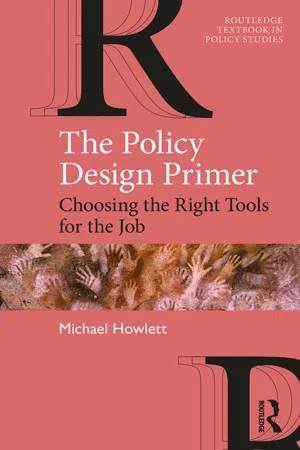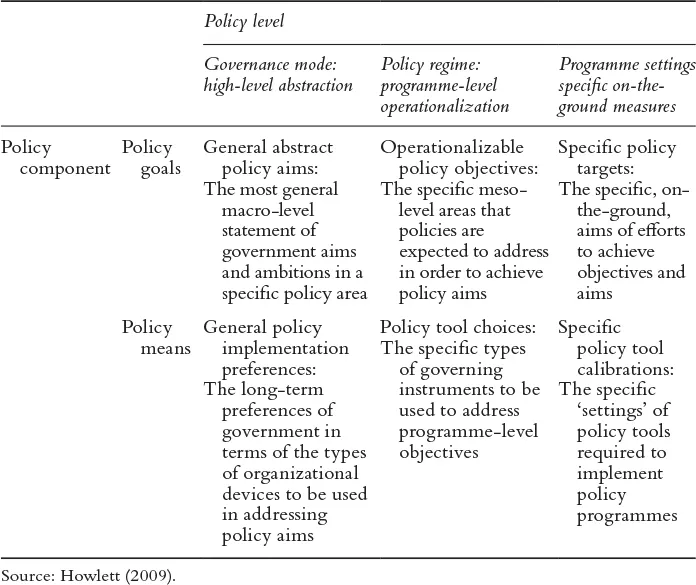1 Basic concepts and vocabulary
Transforming policy ambitions into practice is a complex process. According to Davis Bobrow’s (2006) apt phrase, policy design is ‘ubiquitous, necessary and difficult’. But it is also surprisingly less studied and poorly understood. Unfortunately, many efforts made by policy-makers to address policy problems still fail. But these experiences have fortunately led to a greater awareness of various obstacles that can present themselves to effective policy designs. Efforts to overcome these obstacles, in turn, gradually have fueled a better understanding of the characteristics of the policy process through which design occurs.
Policy design itself entails the conscious and deliberate effort to define policy aims and map them instrumentally to policy tools that are expected to achieve those aims. In this sense, policy design is a particular type of policy formulation, involving activities like collecting knowledge about the outcomes of policy instrument use on policy targets and analyzing its relevance to the creation and implementation of policies meant to attain specific policy goals and aspirations.
The tools orientation towards policy design: authoritative instrumentalism
The origins of policy design studies in the sense used in this book can be traced to the very roots of the policy sciences in the 1950s and 1960s which espoused the overall idea of affecting better outcomes of government actions through the organized application of knowledge to policy-making (Wildavsky 1979). The academic enquiry of policy design – that is, self-consciously dealing with both policy processes and substance from an instrumental perspective – emerged and flourished throughout the 1980s and 1990s (Linder and Peters 1991).
In contemporary policy studies, ‘design’ is associated with both the identification and analysis of policy instruments and their implementation. Policy design in this sense has a substantive element that comprises the technical arrangements of alternatives that could potentially resolve a policy problem at hand, and a procedural component linked to the processes and activities necessary to coordinate the activities of policy actors (Howlett 2011). The contemporary design orientation in policy studies involves thinking about policy design beyond individual policy tool choices to the study of combinations of substantive and procedural instruments and their interactions in sometimes very complex policy mixes. It also has focused on detailed study of the actual formulation processes involved in tool and design choices, as these mixes are created and evolve over sometimes considerable lengths of time.
This chapter provides an introduction to this body of work, setting out the basic concepts and definitions used in the field. Subsequent chapters examine the logic of policy design and the considerations and experiences which are linked to the choices of specific kinds of policy tools found in common designs.
What is public policy?
Public policies are government decisions composed of policy goals and means at different levels of abstraction (Lasswell 1951). Policy goals are the basic aims and expectations governments have in deciding to pursue (or not) some course of action, while policy means are the techniques governments use to attain those goals. Both these elements can be focused on a range of activities, from principles associated with governance arrangements such as free markets or regulation, to more concrete day-to-day administrative programme specifications having to do with topics such as the size of fines levied to discourage activities like littering or theft.
A typical policy contains some very abstract general ‘aims’ or goals, such as, in the cases of criminal justice or education policy, attaining a just society or an innovative one, along with a set of less abstract ‘objectives’ actually expected to achieve those aims such as reducing crime or providing lifelong educational opportunities to members of the public. Further, those objectives themselves must be set down as specific targets or measures which allow policy resources to be directed towards their attainment, such as reducing specific types of crimes such as autotheft or robberies to specific levels within specified periods of time or increasing post-secondary educational attendance or completion by some percentage within a set temporal period.
Similarly, the means or techniques for achieving goals run from highly abstract preferences for specific forms of policy implementation, such as a preference for the use of market, government or non-profit forms of organization in areas such as healthcare, education or crime prevention, to the more concrete level of the use of specific governing tools or mechanisms such as regulation, information campaigns, public enterprises or government subsidies to alter actor behaviour in order to promote or increase wellness, improve educational service delivery or prevent crime. And this runs even further to the most specific level of deciding or determining exactly how those tools should be ‘calibrated’ in order to achieve policy targets, such as providing a specific number of additional police on the streets within a specified period of time, a specific number of kindergarten teachers or a specific level of subsidy to non-profit groups to provide home nursing services.
The principle ‘components’ of public policies involved in any policy design, following this logic, are set out in Table 1.1.
Table 1.1 Components of public policies involved in policy design
What is policy design?
Within the policy sciences, ‘design’ involves the deliberate and conscious attempt to define these policy goals and connect them in a logical or ‘instrumental’ fashion to policy tools thought to be able to achieve them (May, 2003). Policy design, in this sense, is a specific form of policy formulation based on the gathering of knowledge about the effects of policy tool use on policy targets and the application of that knowledge to the development and implementation of each component of a policy. It is an activity conducted by a number of policy actors in the hope of improving policy-making and policy outcomes through the accurate anticipation of the consequences of government actions.
Policy design extends to both the means or mechanisms through which goals are given effect, and to the goals themselves, since goal articulation inevitably involves considerations of feasibility, or what is practical or possible to achieve in given circumstances considering the means at hand. This is the bread-and-butter of policy analytical work undertaken by civil services, think tanks, policy institutes and policy schools which generally examine existing arrangements and propose new or revised solutions felt likely to effectively achieve policy goals.
Not all policy formulation is disinterested or includes this design orientation, however. In many situations, formulators may engage in self-interested behaviour and engage in interest-driven trade-offs or log-rolling between stakeholders or each other, or, more extremely, might engage in venal or corrupt behaviour in which personal gain is the paramount consideration in proposing and advocating for certain kinds of actions and activities. These ‘non-design’ situations are well known in practice but unfortunately are often ignored in studies focusing exclusively on policy designs and designing.
It is also important to note that policy-making and especially policy tool selection are highly constrained processes even when goodwill and a design orientation exists. The exact processes by which policy decisions are taken vary greatly by jurisdiction and sector and reflect the great differences and nuances that exist between different forms of government – from military regimes to liberal democracies and within each type – as well as the particular configuration of issues, actors and problems governments face in particular areas or ‘sectors’ of activity – such as health or education policy, industrial policy, transportation or energy policy and social policy (Howlett et al. 2009). In some circumstances, policy decisions will be more highly contingent and ‘irrational’ or less instrumental than others, that is, driven by situational logics and opportunism rather than careful deliberation and assessment. Such situations and possibilities must always remain at the forefront of policy design studies.
What is a policy instrument?
The policy alternatives which policy designers create are composed of different sets or combinations of policy tools, described in more detail in Chapters 3–6 of this book. Other terms have been developed in the field of policy studies to describe the same phenomenon, such as ‘governing instruments’, ‘policy instruments’ and the ‘tools of government’, and while these sometimes are used to refer to different things, they are more often used synonymously. These tools are the subject of deliberation and activity at all stages of the policy process and affect both the agenda-setting and policy formulation processes as well as being the subject of decision-making, policy implementation and evaluation.
Taken together, the tools of government comprise the contents of the toolbox from which decision-makers must choose in building or creating public policies. Policy design elevates the analysis and practice of these po...

